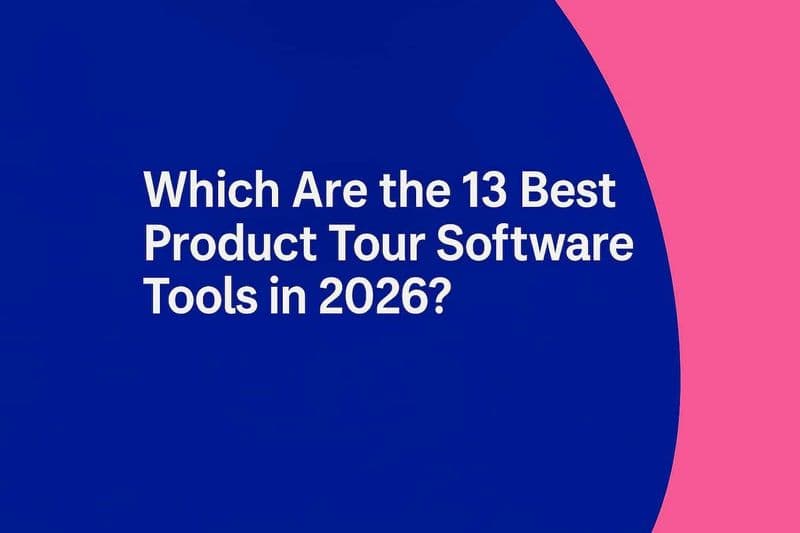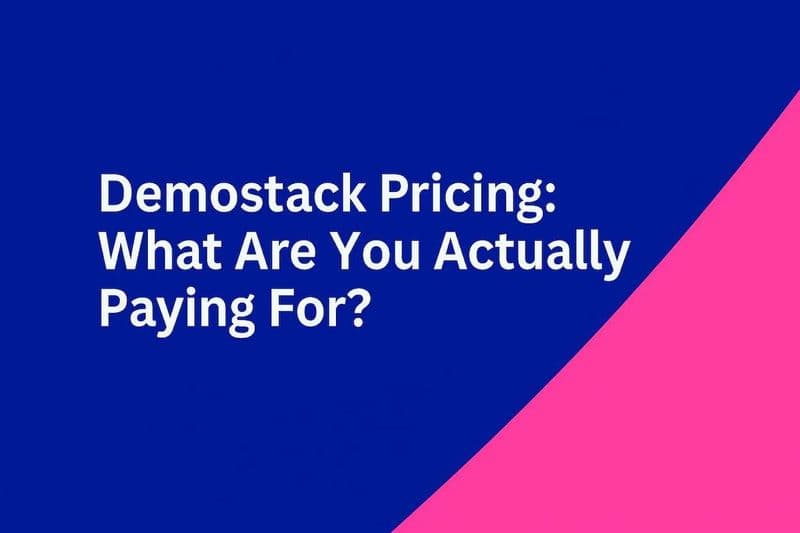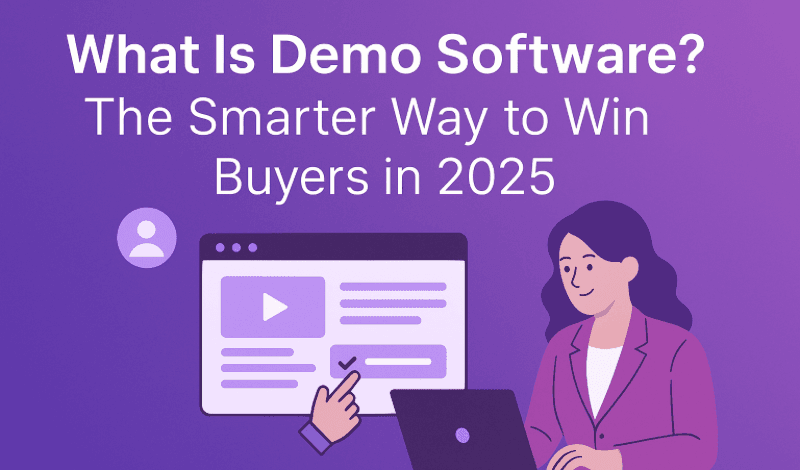
TL;DR
|
We’ve all been there: stuck in a sales call where the rep drones on, reading bullet points off a never-ending slide deck. It feels less like exploring a solution and more like being trapped in a lecture hall with no exit sign. By the time they get to the “exciting” part, we’re already planning dinner.
The real issue isn’t that the product lacks value. It’s that the way it’s presented doesn’t connect. Buyers today don’t want vague promises or live sales demos that drag on. They want a hands-on demo experience where they can explore at their own pace, see specific features, and quickly judge whether a tool solves their unique challenges. Nobody has ever walked away from a 60-slide PowerPoint thinking, “That was a great demo.”
That’s why demo software exists. It flips the script, instead of forcing prospects to sit through static presentations, it gives them an interactive experience that feels closer to a real test drive. In this blog, we’ll break down what is demo software, why it matters, the different demo types, and how businesses use it to close deals faster.
What Is Demo Software?
Demo software is a tool that lets prospects try a product before they buy it. Instead of sitting through slide decks or scripted pitches, buyers get an interactive demo experience that shows them how the product works in practice.
It can take the form of interactive product tours, video demos, or live demo environments. The goal is simple: highlight the right features, connect them to real use cases, and make it easy for buyers to see the value without extra friction.
For sales teams, marketers, and customer success, demo software works like a product experience platform. Sales reps can run tailored sales demos, marketing can share engaging demo content, and sales engineers can set up safe demo environments with real data. It’s a faster, clearer way to move prospects through the sales cycle and close deals.
Why Is Demo Software Important in 2025?
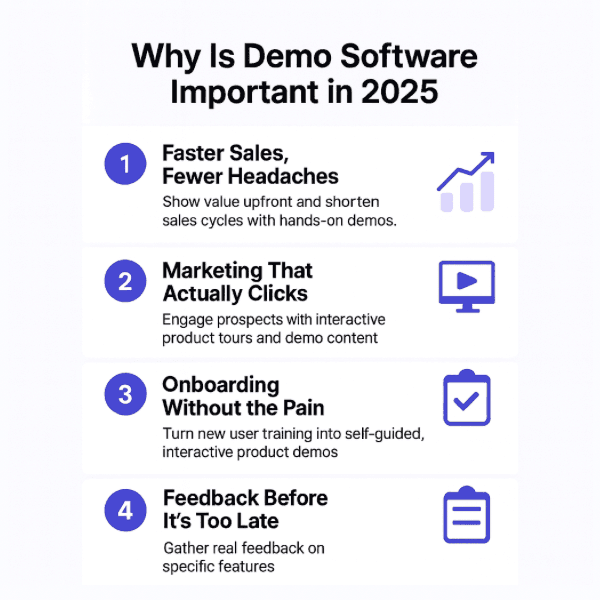
Ever sat through a deal that dragged on for weeks, only to end with “we’re not interested”? We’ve been there too. The way we sell, market, and onboard has changed, and demo software is what keeps the process moving fast, clear, and buyer-friendly.
1. Faster Sales, Fewer Headaches
Nobody likes a dragged-out sales cycle. Demo software helps sales teams cut straight to the good part, showing value. By giving prospects a hands-on look, sales reps spend less time explaining and more time moving qualified leads down the sales pipeline. Result? Shorter cycles, higher conversions, and fewer lost deals.
2. Marketing That Actually Clicks
Static ads and endless PDFs don’t excite anyone. But an interactive demo? That grabs attention. Marketers can drop product tours on landing pages, share demo content on social media, or use video demos in campaigns to keep prospects engaged longer. It’s content that prospects don’t just scroll past, they click through.
3. Onboarding Without the Pain
Customer success teams know the struggle of explaining the same thing 50 times. Demo software turns training into self-guided, interactive product demos where new users learn at their own pace. That means fewer support tickets, smoother adoption, and happier customers.
4. Feedback Before It’s Too Late
Demo environments can double as testing grounds. Product teams can roll out specific features in interactive demo software, gather real feedback, and fix pain points before launch. That’s a lot cheaper (and less embarrassing) than waiting until the product is already live.
What Are the Different Types of Demo Software?
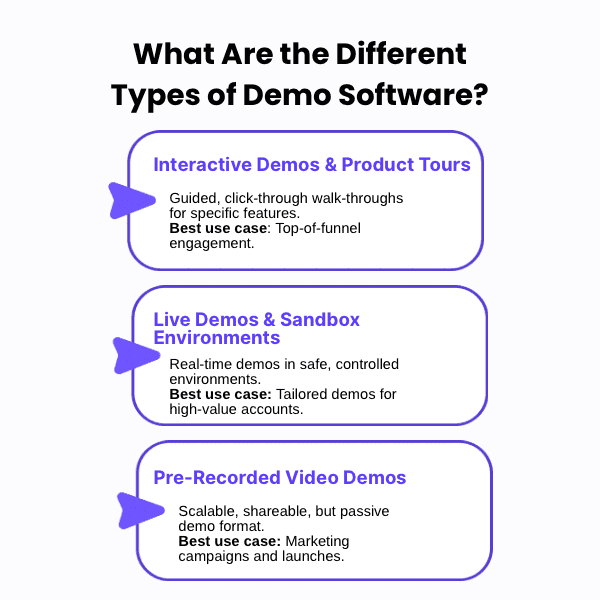
Not all demos are built the same. Some are quick and click-through, others happen live on a sales call, and a few let prospects wander around on their own. The trick is knowing which type works best for your buyers and when to use it.
1. Interactive Demos & Product Tours
Think of this as a guided walk-through where prospects click through screens and see how things work. It’s lightweight, easy to share, and perfect for showing specific features without overwhelming anyone.
Best use case: Top of funnel engagement: landing pages, email campaigns, social media teasers.
2. Live Demos & Sandbox Environments
This is your classic real-time sales call, but with a twist. Sandbox environments give reps a safe space to run demos without breaking the real product. It’s live, but less risky.
Best use case: Sales engineers and sales reps running tailored demos for high-value accounts.
3. Pre-Recorded Video Demos
Quick, scalable, and always available. The downside? They’re passive; viewers can watch but not interact. Still, they work when you need reach without the setup.
Best use case: Marketing campaigns, product launches, or when you need to demo at scale.
4. Free Trials vs. Demo Automation Platforms
Free trials let prospects explore the entire product, but they often get lost or distracted. Demo automation platforms, on the other hand, guide users through exact use cases and cut down manual work.
Best use case: Free trial for self-serve users, demo automation for teams wanting structured, interactive demo use cases tied to sales pipeline goals.
Try SmartCue’s 14 days free trial today!
Why Do Teams Rely on Demo Software to Win Deals?
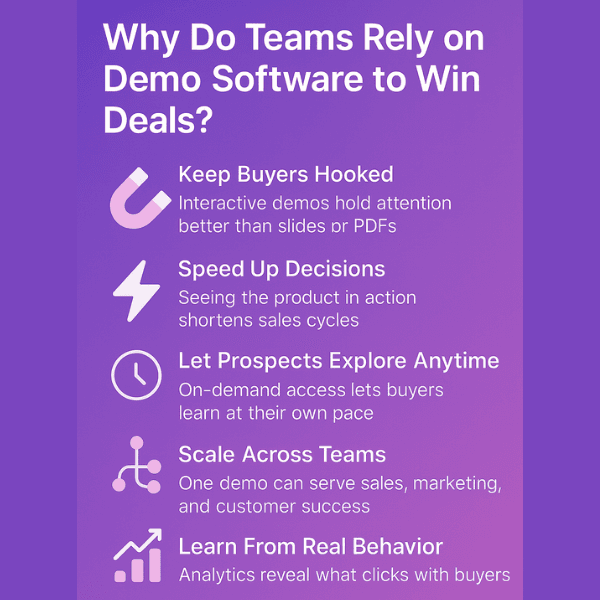
We’ve all had prospects nod along politely in a meeting, only to ghost us afterward. Most of the time, the problem isn’t the product, but it’s how the value was shown. Demo software flips that dynamic, making it easier for buyers to engage, understand, and decide.
1. Keep Buyers Hooked
Slides and PDFs rarely hold attention. An interactive demo pulls prospects in, lets them click around, and makes the product feel real, so the conversation shifts from “what does it do?” to “how can we start?”
2. Speed Up Decisions
Talking through features only goes so far. When buyers see the product in action, the lightbulb moment happens faster. That clarity shortens the sales cycle and helps us close deals without endless back-and-forth.
3. Let Prospects Explore Anytime
Not every buyer wants to wait for a live call. With on-demand demos, prospects can explore at their own pace, revisit flows when questions pop up, and share the experience with decision-makers.
4. Scale Across Teams
Why create separate decks for sales, marketing, and customer success when one demo can do the job for all three? A single interactive asset works across the funnel, driving pipeline at the top, supporting conversations in the middle, and helping onboard at the end.
5. Learn From Real Behavior
Instead of guessing what resonated, demo analytics tell us exactly where prospects clicked, what caught their interest, and what they skipped. Those insights sharpen future demos and keep us focused on solving the right problems.
What Can Demo Software Do for Your Business?
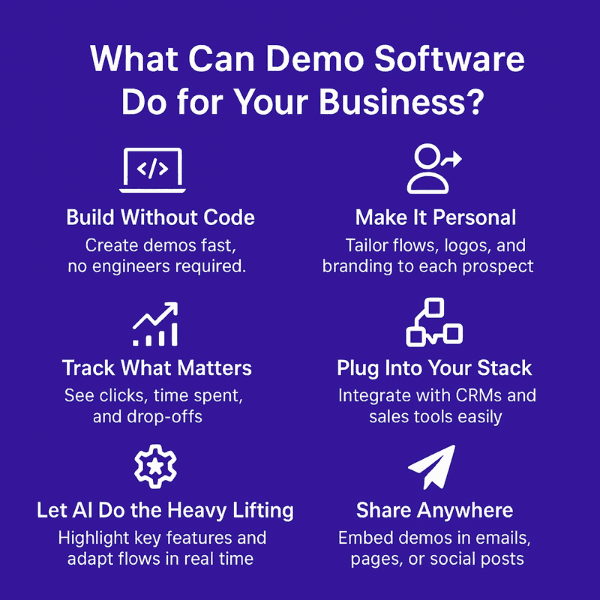
We’ve all sat through demos that either crash mid-call or feel so cookie-cutter they could be about any product. Modern demo software is designed to fix that. It gives us the tools to create experiences that are reliable, relevant, and engaging, without the clunky workarounds. Here’s how it delivers.
1. Build Without Code
Nobody wants to submit a ticket and wait weeks for engineering just to get a demo ready. No-code creation puts that control into the hands of sales reps and marketers. We can spin up demos quickly, tweak them as needed, and respond to prospect requests without adding extra work for developers.
2. Make It Personal
A generic walkthrough doesn’t convince anyone. With personalization, we can insert logos, match branding, and tailor flows to exact use cases. When prospects see their own world reflected in the demo, the product feels like a fit from the very first click.
3. Track What Matters
Instead of guessing which parts of the demo landed, engagement analytics tell us exactly what buyers paid attention to. We can see which features they explored, how long they stayed, and where they dropped off. That kind of visibility helps us refine demos and focus on the pain points that matter most.
4. Plug Into Your Stack
Demos work best when they’re connected to the rest of the sales process. With CRM and sales tool integrations, we can track demo activity alongside pipeline stages, trigger follow-ups automatically, and keep the entire team aligned on what prospects have actually seen.
5. Let AI Do the Heavy Lifting
AI takes demo customization to the next level. It can automatically highlight key features, adjust flows in real time based on user behavior, and even recommend the next step. Think of it as having a built-in sales engineer quietly making sure every prospect sees exactly what they need.
6. Share Anywhere
A demo shouldn’t only happen on a live call. Cross-channel shareability means we can embed demos into emails, landing pages, or even social posts. Prospects can interact with the product wherever they are, at their own pace, without waiting for us to schedule time.
How to Choose the Right Demo Software (Without Wasting Time)?
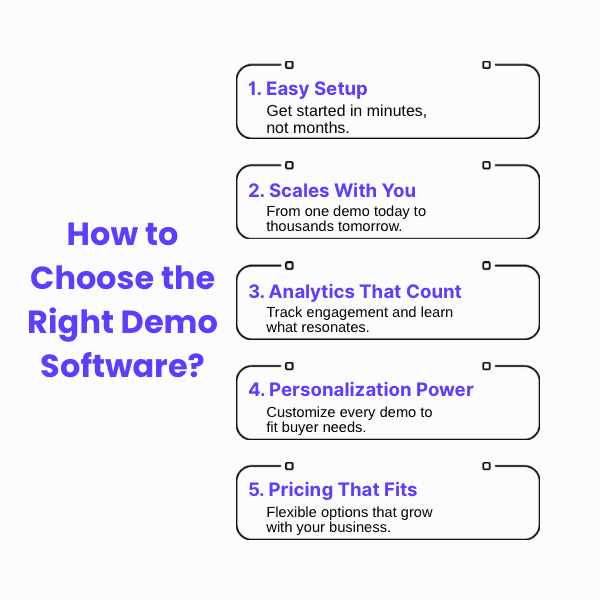
Shopping for demo software can feel like a paradox; you need a tool to show value fast, but evaluating the options can drag on forever. Here’s the checklist we lean on to cut through the noise:
1. Easy Setup
If a tool requires an army of engineers just to get started, it defeats the purpose. The best demo software should be ready to roll in minutes, not months, so you can focus on showing value, not wrangling setup.
2. Scales With You
One demo might be enough for today, but what about next quarter when you need dozens, or even thousands, for different accounts and use cases? Choose a platform that scales without adding friction or cost.
3. Analytics That Count
A demo isn’t just about showing; it’s about learning. The right tool will track clicks, time spent, and drop-offs, giving you real insights into what resonates with prospects and what doesn’t.
4. Personalization Power
Generic walkthroughs don’t inspire action. Your demo software should make it simple to tailor flows, swap in a prospect’s logo, or highlight the exact features that matter to them, so every buyer feels like the demo was built for their world.
5. Pricing That Fits
You don’t need bloated enterprise costs when you’re just starting out, but you also don’t want to outgrow a tool too quickly. Look for flexible pricing that works for your stage today and scales fairly as you grow.
That’s exactly the approach we’ve taken with SmartCue, making it easy to set up, effortless to personalize, built to scale, and packed with analytics that tell you what buyers really care about. Instead of waiting weeks for demos that fall flat, you can create tailored experiences in minutes.
Want to see for yourself? Try SmartCue for free for 14 days and discover how simple, interactive demos can transform your sales conversations.
Stop Giving One-Size-Fits-All Demos. Start With SmartCue.
We’ve all seen what happens when a generic demo hits the screen: prospects lose interest, the conversation drifts, and by the end of the call everyone’s politely nodding instead of leaning in. The truth is, buyers don’t want a standard product tour—they want to see their problems solved in their context.
That’s where SmartCue comes in. We built it to make personalized demos not just possible, but effortless. With our no-code Chrome extension, you can capture your product once and turn it into a library of interactive demos. From there, it’s easy to tailor flows for different industries, roles, or even individual accounts—so every prospect sees what matters most to them.
And it doesn’t stop there. SmartCue helps your team:
Create at speed – No waiting on developers. Build demos in minutes, not weeks.
Personalize at scale – Swap logos, highlight specific features, or customize flows for every use case.
Share anywhere – Send demos as links, embed them in emails or landing pages, or export them as GIFs, videos, or PDFs.
Track engagement – See exactly where prospects click, how long they spend, and which features spark interest.
Collaborate as a team – Sales, marketing, and customer success can all work from the same demo library.
In the words of our founder: “Traditionally, creating, maintaining, updating demos, and giving contextual demos was hard and time & resource-intensive. With SmartCue, I want to change that by making it fast and easy for you to create personalized product demo libraries for EVERY prospect!”
Here’s a short video that shows you how SmartCue works.
Ready to see it in action? Book a Live Demo →
How Can SmartCue Help You Turn Interest Into Sales?
Creating a demo shouldn’t feel like another project on your to-do list. With SmartCue, you can launch a personalized product demo in just a few minutes. Here’s how simple it is:
Step 1: Get Started
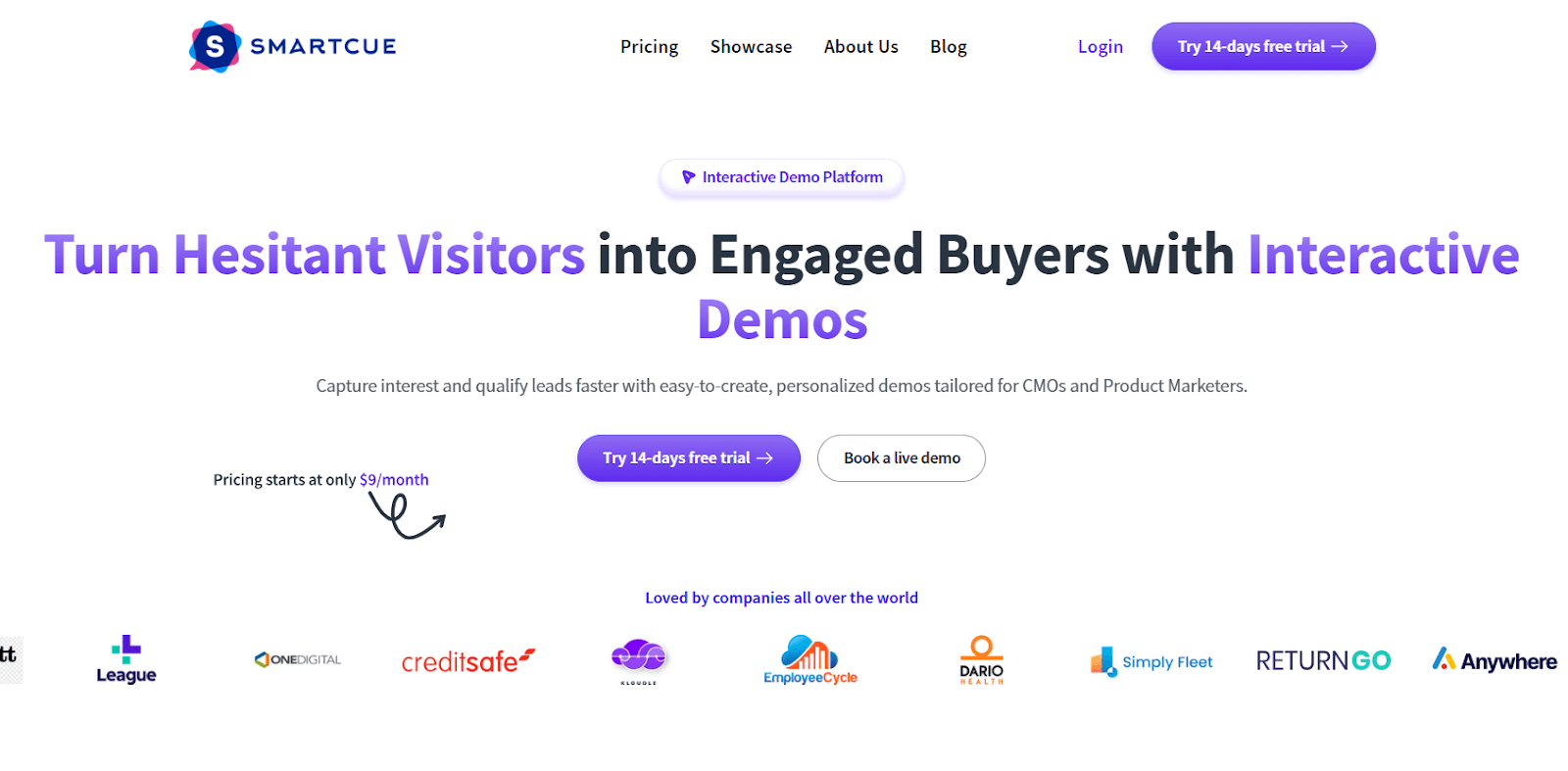
Sign up for a free trial and log in. The dashboard is clean, intuitive, and built so you can hit the ground running.
Step 2: Capture Your Product
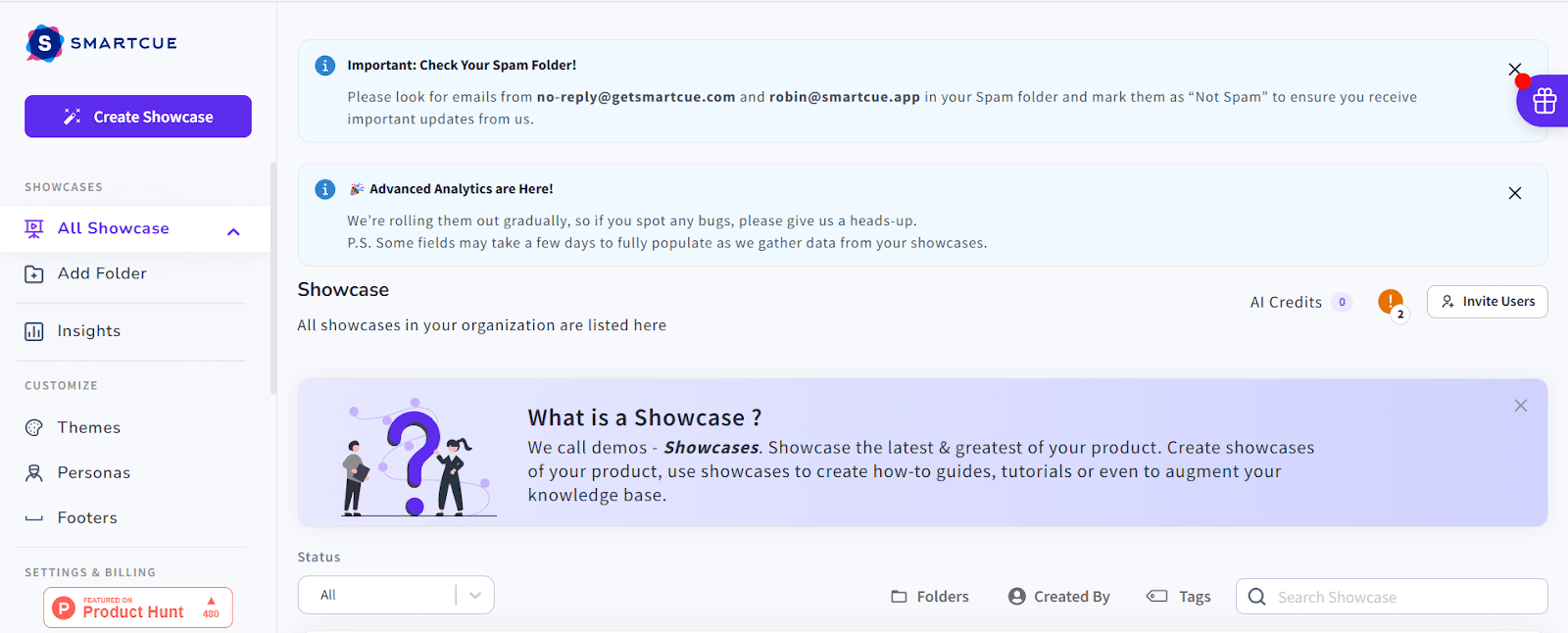
Kick off a new showcase by uploading your content or using the SmartCue browser extension to quickly capture your product in action.
Step 3: Customize the Experience
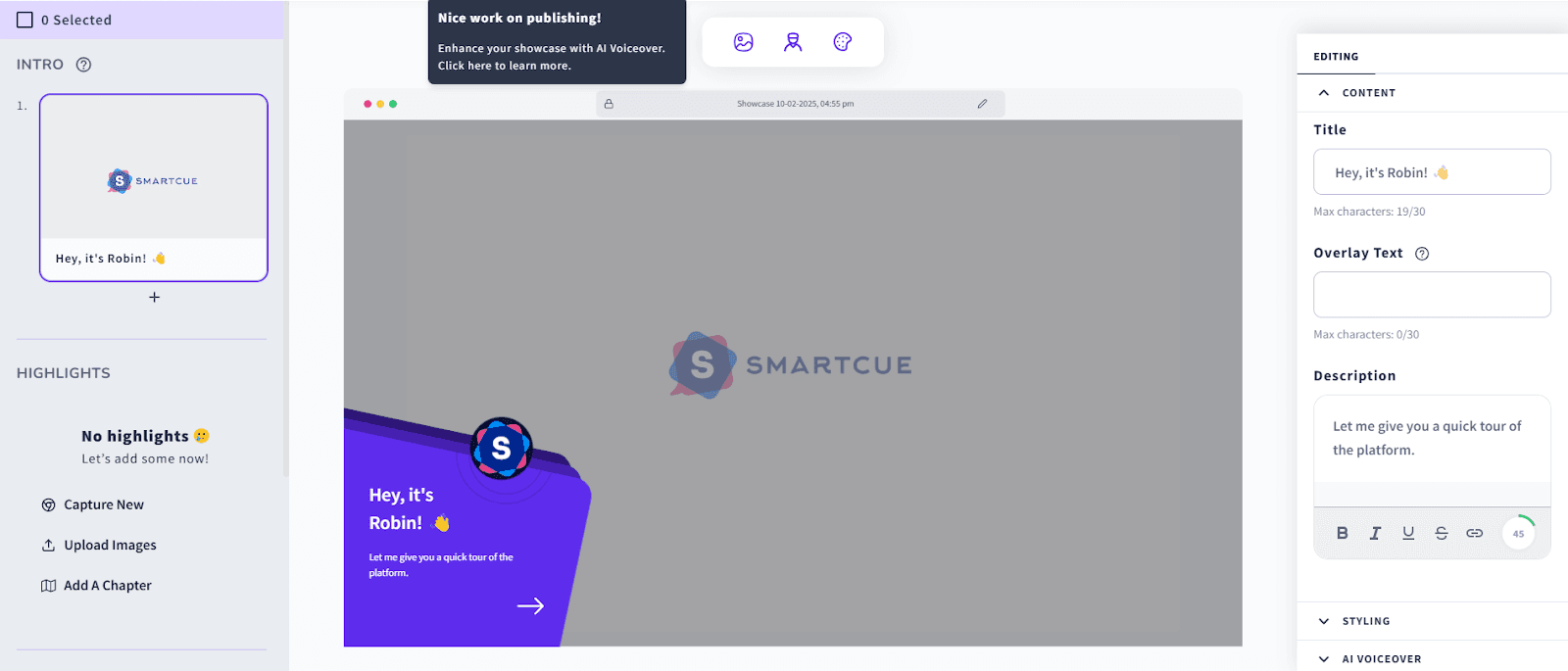
Highlight the features that matter, add helpful text, and use SmartCue’s built-in tools to make your demo engaging and clear.
Step 4: Share With Prospects
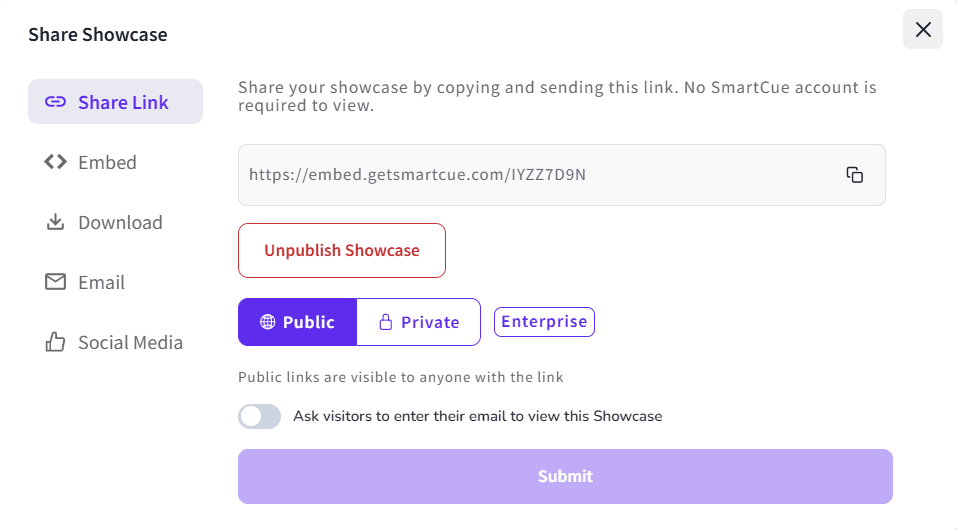
Once it looks right, publish and share your demo instantly—whether that’s through a link, an email, or embedded on a landing page.
Turning Demos Into Growth Engines
The way we sell software has changed. Buyers no longer want long presentations or endless explanations; they want to experience the product, see how it fits their workflow, and feel confident before they commit. That shift puts demo software at the heart of modern sales and marketing.
But here’s the real takeaway: choosing the right demo software isn’t just about having a shinier presentation. It’s about giving your prospects clarity, your team efficiency, and your business a faster path to revenue. When done well, a demo stops being a sales tactic and becomes a growth engine.
And that’s where tools like SmartCue step in. By making demos easy to build, personalize, and share, SmartCue helps you meet buyers where they are—with the kind of experiences that actually move deals forward.
So the question isn’t whether you need demo software, but it’s how quickly you want to start using it to win more business.
Frequently Asked Questions
What are the main types of demo software available and how do they differ?
The main types include interactive product tours, live demos with sandbox environments, and pre-recorded video demos. Interactive demos allow hands-on exploration, live demos offer tailored conversations, while video demos scale outreach but remain passive. Each serves a unique stage of the funnel.
How can demo software help businesses convert prospects more efficiently?
Demo software reduces friction in the sales cycle by showing value directly. Instead of long explanations, prospects experience how the product solves their problems. This clarity builds trust, speeds up decisions, and helps businesses close more qualified deals with less effort.
What features should I look for when choosing demo software for my company?
Key features include no-code setup, easy personalization, analytics for tracking engagement, CRM integrations, AI-powered customization, and simple sharing options. These capabilities ensure you can build demos quickly, adapt them to buyer needs, and measure what actually drives conversion.
How do I decide which sales demo software is best for my organization?
Focus on your team’s specific needs: speed of setup, ability to scale, and depth of analytics. Consider pricing flexibility and ease of use. The right software should save time, enable personalization, and seamlessly fit into your existing sales process.
How to present software demo?
Keep it simple, relevant, and engaging. Start with the buyer’s pain points, highlight only the most relevant features, and use storytelling to connect product value to their goals. Avoid feature overload, instead focus on solving problems, not showing everything at once.
Are there any examples of companies successfully using demo software?
Yes. SaaS companies across sales, marketing, and customer success use demo software to personalize product experiences. Many report shorter sales cycles, better buyer engagement, and improved onboarding because prospects see real value upfront instead of sitting through generic presentations.
